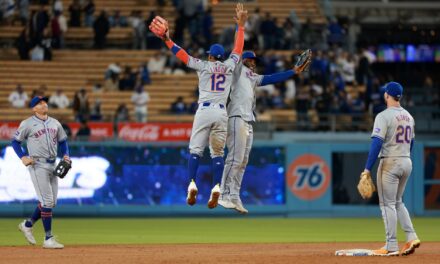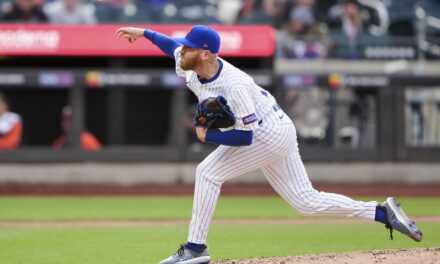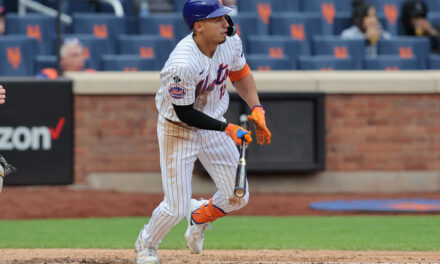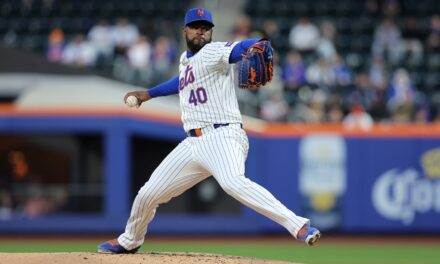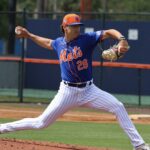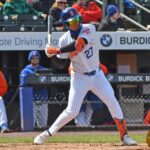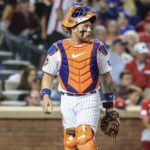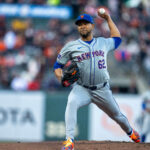
Credit: Vincent Carchietta-USA TODAY Sports
One of the more highly-anticipated changes of the 2023 baseball season is the limitation of the shift. Since its widespread inception at the beginning of the 2010s, batting averages have plummeted, leading to a further emphasis on home runs and launch angle. Batting average with balls in play (BABIP) became too risky to rely on, as teams took advantage of batters’ inability to “hit it where they ain’t” and blanketed the right side of the infield.
The shift will not be totally eliminated, but the requirement for two fielders on either side of second base gets rid of the three-man right side that most left-handed hitters have been grappling with for a decade. The Mets will have defensive adjustments to make, as they shifted the ninth-most among all MLB teams. (Interestingly, though, the Mets shifted far more often comparatively against righties than lefties, ranking fifth with a 31.5% shift rate against right-handers while just 23rd with a 47% rate vs. lefties.)
On the offensive side of the plate, that’s where things will get interesting for the Mets. As a contact-driven team, where fielders are positioned is of significant interest to them. How will the limitations on the shift affect the Mets’ presumed starters, if at all?
Jeff McNeil
No discussion of anything ball-in-play-related can be complete without talking about Mr. Hit-It-Where-They-Ain’t himself, Jeff McNeil. The Squirrel is the ultimate contact hitter. McNeil is somewhat of an analytics anomaly, as he routinely outperforms his expected metrics without any expectation of regression. That’s just who he is.
Over the last two seasons, McNeil’s wOBA with the shift has been 70 and 41 points higher, respectively, than without it. The rate of shifts against him has fluctuated considerably throughout his career, from a low of 19.4% in 2018, his rookie year, to a high of 42.1% in 2021. The 22.1% rate from 2022 appeared to be a recognition that McNeil was back to his contact ways.
McNeil’s .426 BABIP against the shift in 2022 was so absurd that it became a running joke among GKR, the Mets’ wonderful TV broadcast trio of Gary Cohen, Keith Hernandez, and Ron Darling.
Keep shifting on Jeff McNeil.
I'm sure that strategy will work. (by the way, he's 3-for-3) pic.twitter.com/bzEe6wl88E
— SNY (@SNYtv) June 1, 2022
As Mike Petriello of MLB.com detailed, McNeil will undoubtedly adjust for that lack of BABIP supremacy against the shift. It may cause a slight dip in his overall hitting metrics, but McNeil is a line-drive artist, ranking seventh among qualifiers at 23.8%. He’ll stop adjusting his stance to account for the lack of fielders on the right side and hit more to all fields, as he is wont to do, anyway.
The Squirrel is unlikely to be much affected by the lack of a shift. He’s one of baseball’s few remaining pure hitters.
Daniel Vogelbach
You’d think that Daniel Vogelbach would be the classic lefty hitter destroyed by the shift: big, slow, unable or unwilling to change his hitting stance. However, Vogelbach was shifted on 76.4% of the time in 2022, and his splits were stark in an unexpected manner: his wOBA was .279 without the shift and .368 with it. He was like this in 2021, as well, although his splits were the reverse (albeit not as dramatic) in 2019-20.
To be fair, Vogelbach is a fly-ball hitter more than groundball, but he is a pretty strong pull hitter, doing so 40.7% of the time in 2022 and 38.4% for his career (above the MLB average of 36.8%). It’s hard to figure out exactly how Vogelbach will be affected by the shift changes, although the effect could potentially be dramatic for the positive or negative.
Brett Baty
In a small sample size, Brett Baty‘s differences in wOBA with and without the shift were dramatic. His wOBA without the shift was .277, while with it, it was .138. However, teams shifted against Baty only 11.9% of the time, surprisingly.
Over the course of a season, a batter with Baty’s profile is likely to benefit from the lack of a shift. Although he hit to all fields in his cameo last season (30% or above to both the pull and opposite fields and straightaway), his 56.7% groundball rate and 91.1 mph average exit velocity suggest that he’s hitting a lot of hard groundballs. The positioning of fielders will make a big difference on those kinds of balls.
The Mets hope that Baty finds his power stroke and begins to elevate the ball more as he gains more experience, but especially in the early going, a steady diet of hard groundball contact is likely. Baty will get on base more often without fielders positioned perfectly to stop him, as his .332 xwOBA from last season implies.
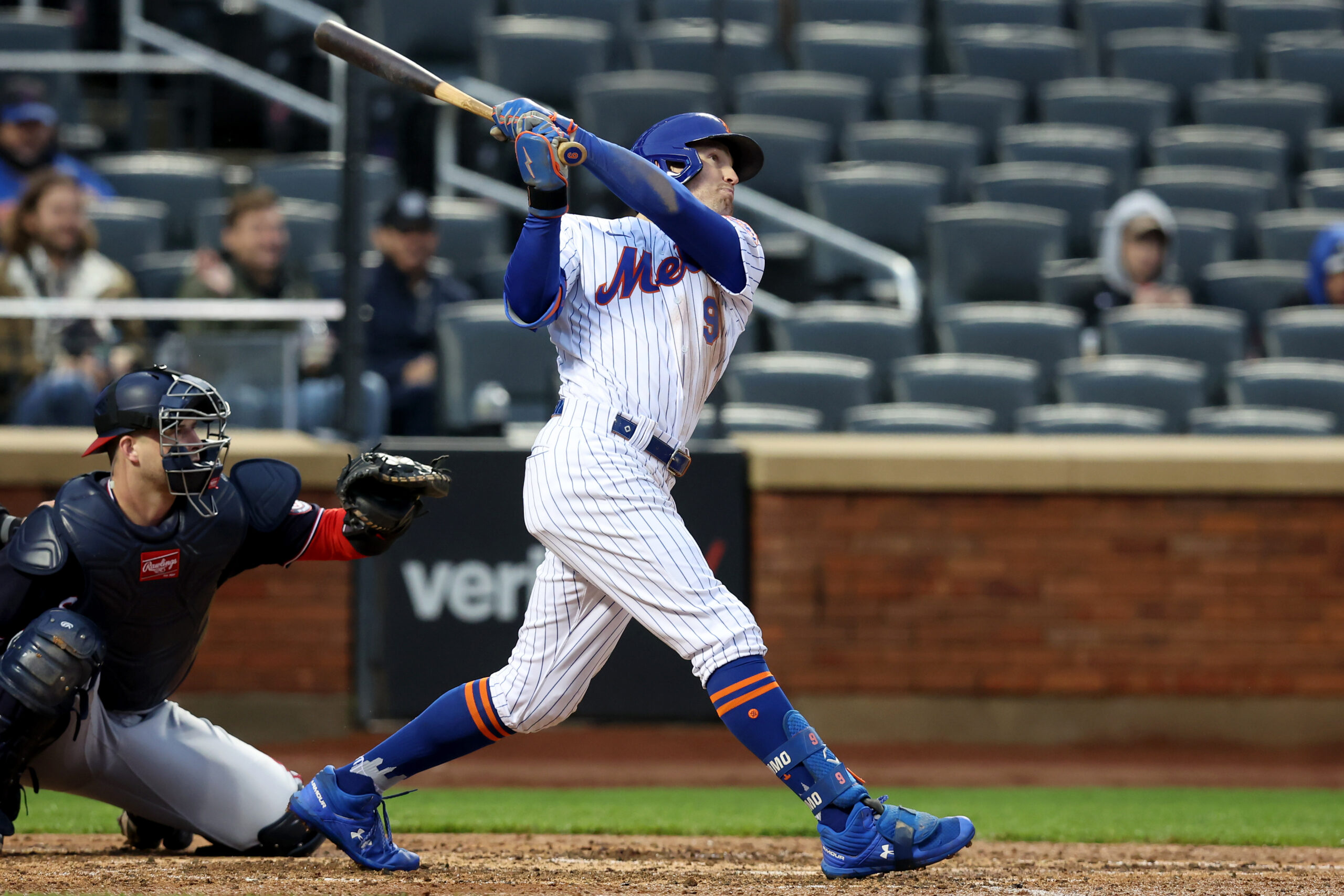
Brad Penner-USA TODAY Sports
Brandon Nimmo
Since Brandon Nimmo is left-handed, he’s another hitter who can be affected by the lack of a shift. Nimmo has been a bit all over the place against the shift; his wOBA with the shift was 30 points lower than without it in 2022, but it was 65 points higher in the reverse direction in 2021. His shift rates have also fluctuated, from a high of 38.1% in 2019 to a low of 12% in 2020. He was at 32.3% in 2021 but just 15.3% in 2022.
Based on Nimmo’s 2022 performance, it would seem that the limitations on the shift would be a slight boost for him. However, given his career, I don’t think this change will have too much of an effect on Nimmo overall. We know who he is: a strong on-base presence who is good at hitting to all fields and hits the ball on the ground a lot. That last bit (career groundball rate of 47.6%, which is above the MLB average of 44.9%) suggests some positive changes without the shift, but again, Nimmo is who he is.
Omar Narváez
The Mets’ new catcher is left-handed, which means a look at his shift metrics is warranted. Over the last three seasons, teams have shifted over 50% of the time against Omar Narváez. The results are interesting: Narváez was better with the shift in 2020 and 2022 but worse in 2021. Narvaez does go to the opposite field a fair amount (28.3% for his career, above the 25.4% MLB average), so it would make sense that he can beat the shift.
However, Narváez also profiles as more of a fly ball and line-drive hitter over groundballs, which would make infield changes have less of an effect on his hitting. He has not exceeded a 40% groundball rate in the last 5 seasons, and the MLB average is 44.9%. Meanwhile, even with a dip in his fly ball rates last year from over 30% in 2020-21 to 26.9% in 2022, he is still above the MLB average of 23.1%, and his career 28.8% line-drive rate is above the 25.0% average. He even pops up less than average, doing so just 4.8% of the time in 2022 against the MLB average of 7.1%.
Francisco Lindor
Francisco Lindor is a switch-hitter, and he was shifted against 61.3% of the time as a left-handed batter, which ranked 142nd among position players from one side of the plate. Lindor’s wOBA was actually somewhat higher against the shift than without it (.350 vs. .331). This may be accounted for by the difference in his BABIP as a lefty vs. righty, as it was .308 as a left-handed batter and .286 from the right side.
For most of Lindor’s career, he has been slightly better by wOBA with the shift than without, though the difference is not usually dramatic. He is unlikely to be significantly affected by the rule changes.
Pete Alonso
Pete Alonso is right-handed, but he needs to be listed just because of his power. Teams tend to shift against power hitters, and Alonso was shifted on 41.2% of the time, well above the league average of 19.6% against righties as a whole.
Over the last two seasons, Alonso’s wOBA has been lower with the shift than without; it was .391 without the shift in 2022, while .331 with it. That would imply an expected jump, but Alonso’s splits were dramatically the reverse in 2020, .284/.424 without and with the shift, respectively, albeit in 1/3 of the at-bats.
Alonso is a flyball hitter, but he is also a pull hitter, which is where his power stroke primarily lies. He could possibly see a slight uptick in his .274 career BABIP for the 2023 season.


